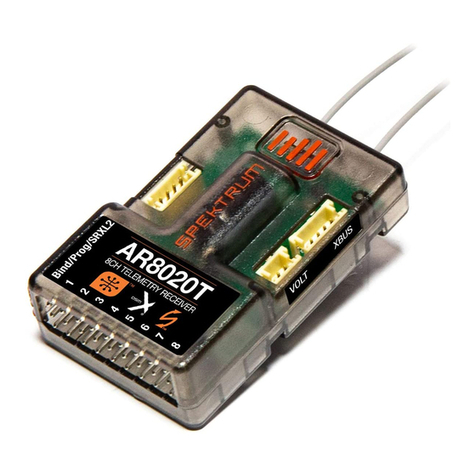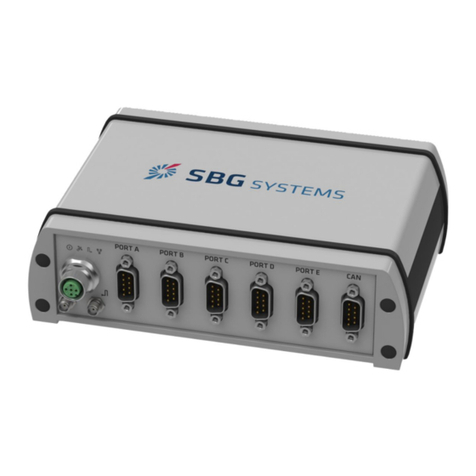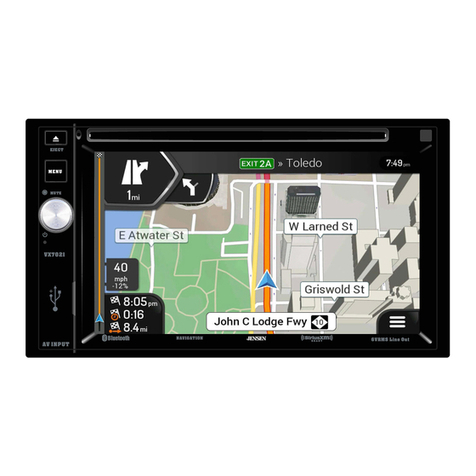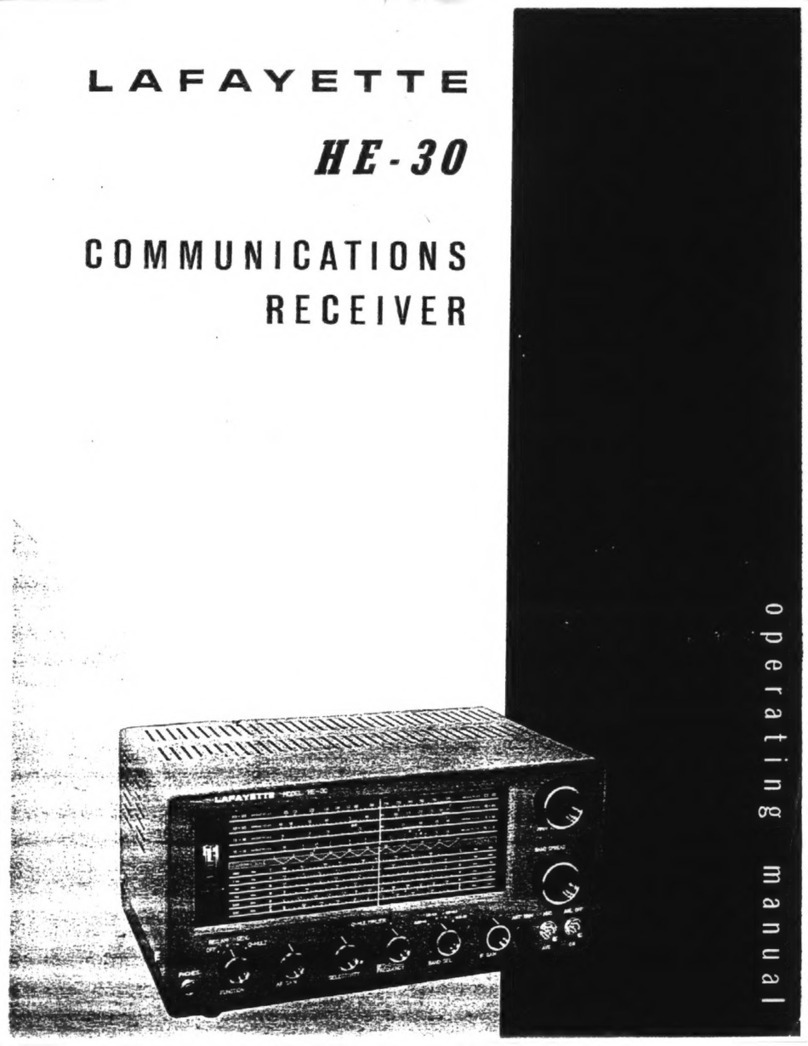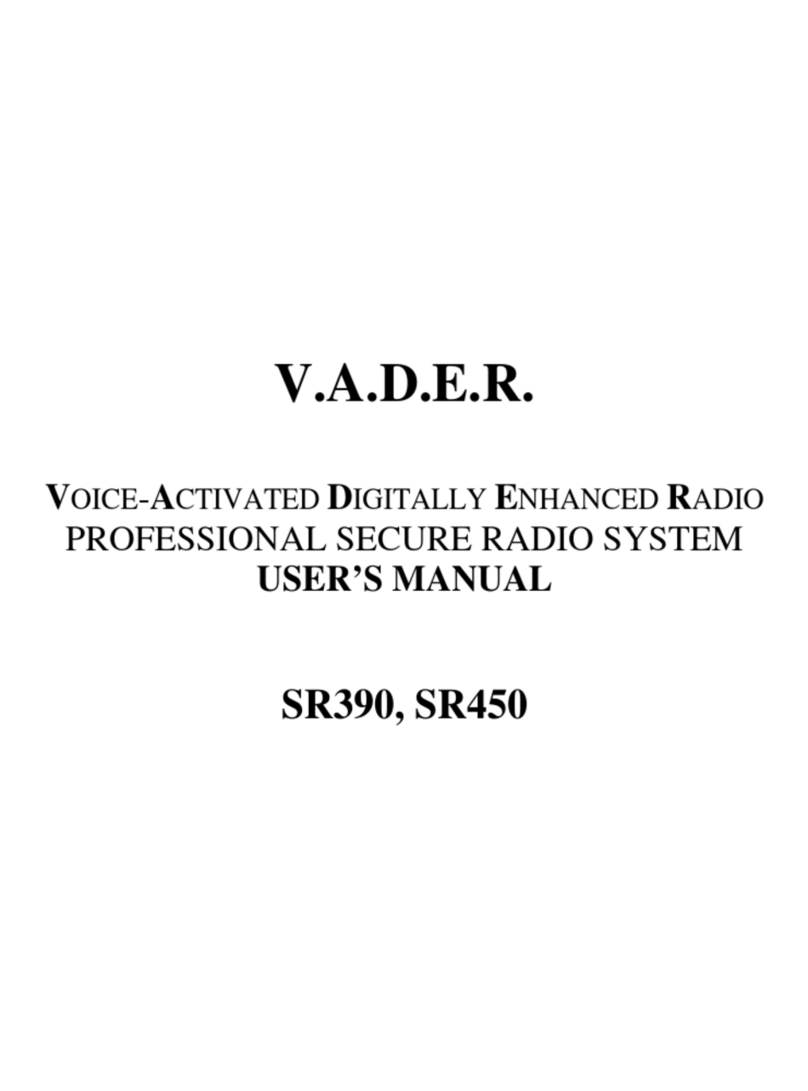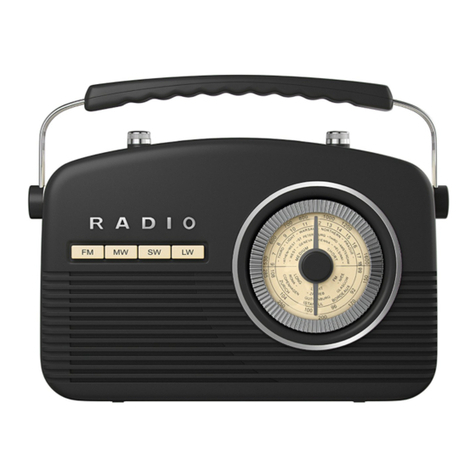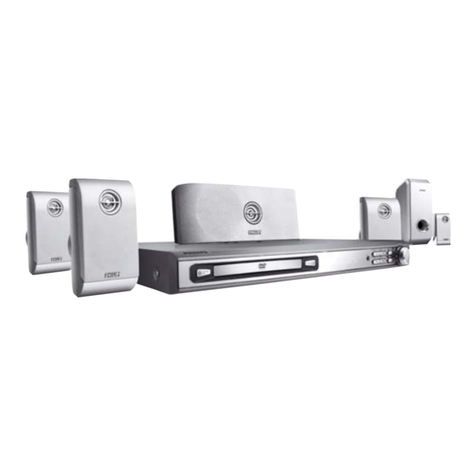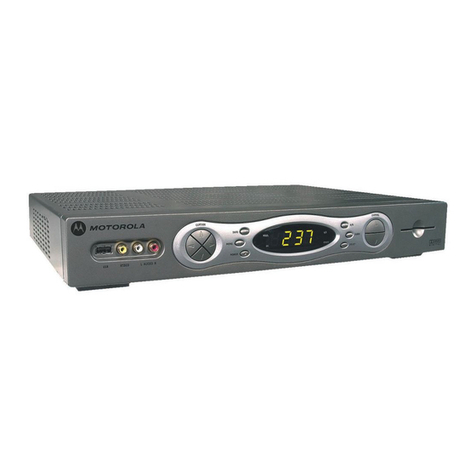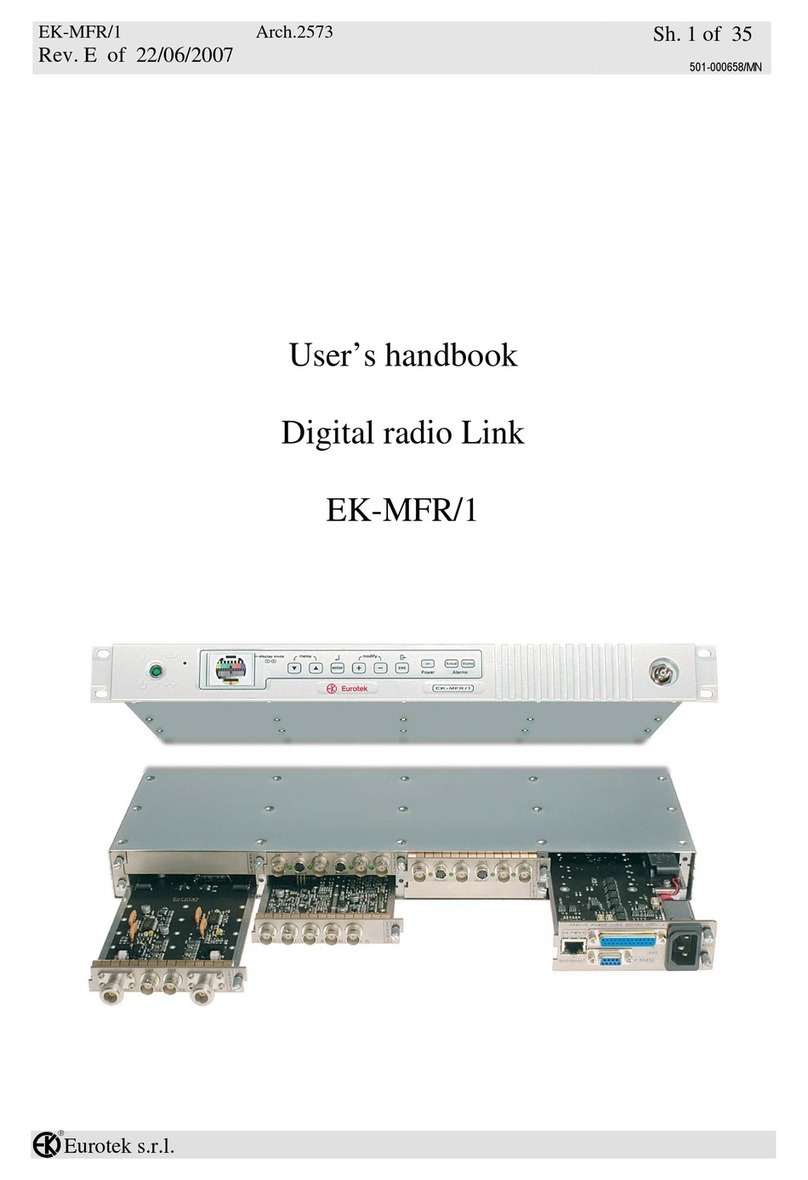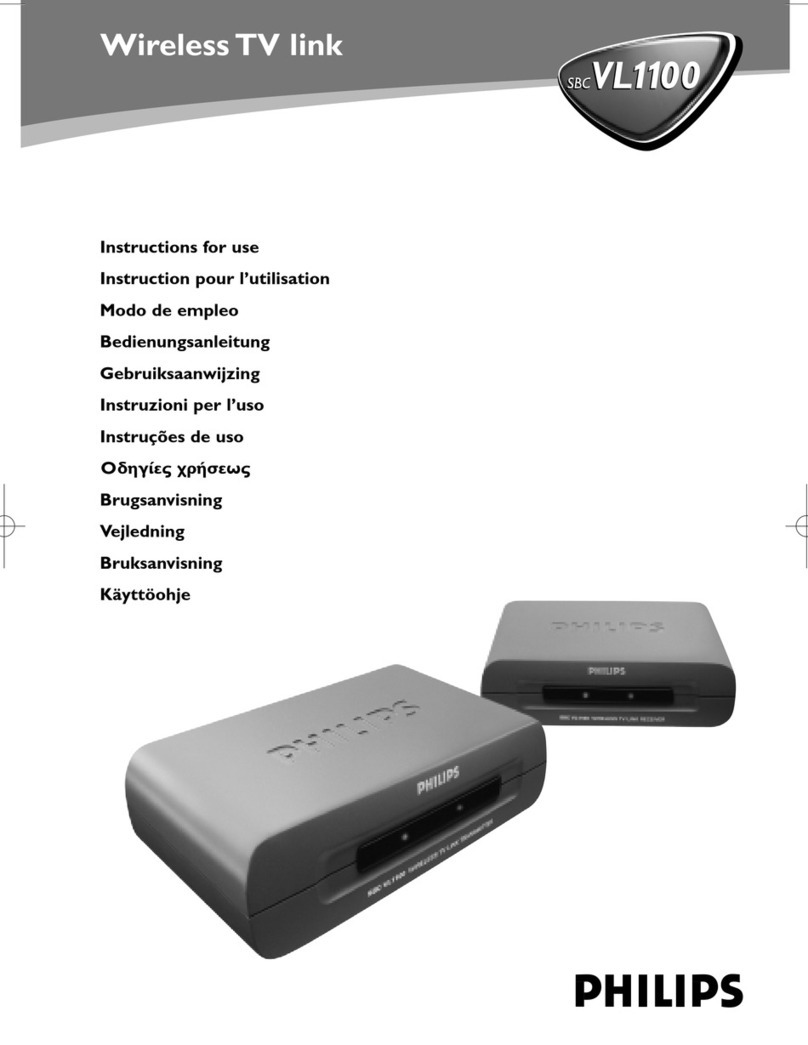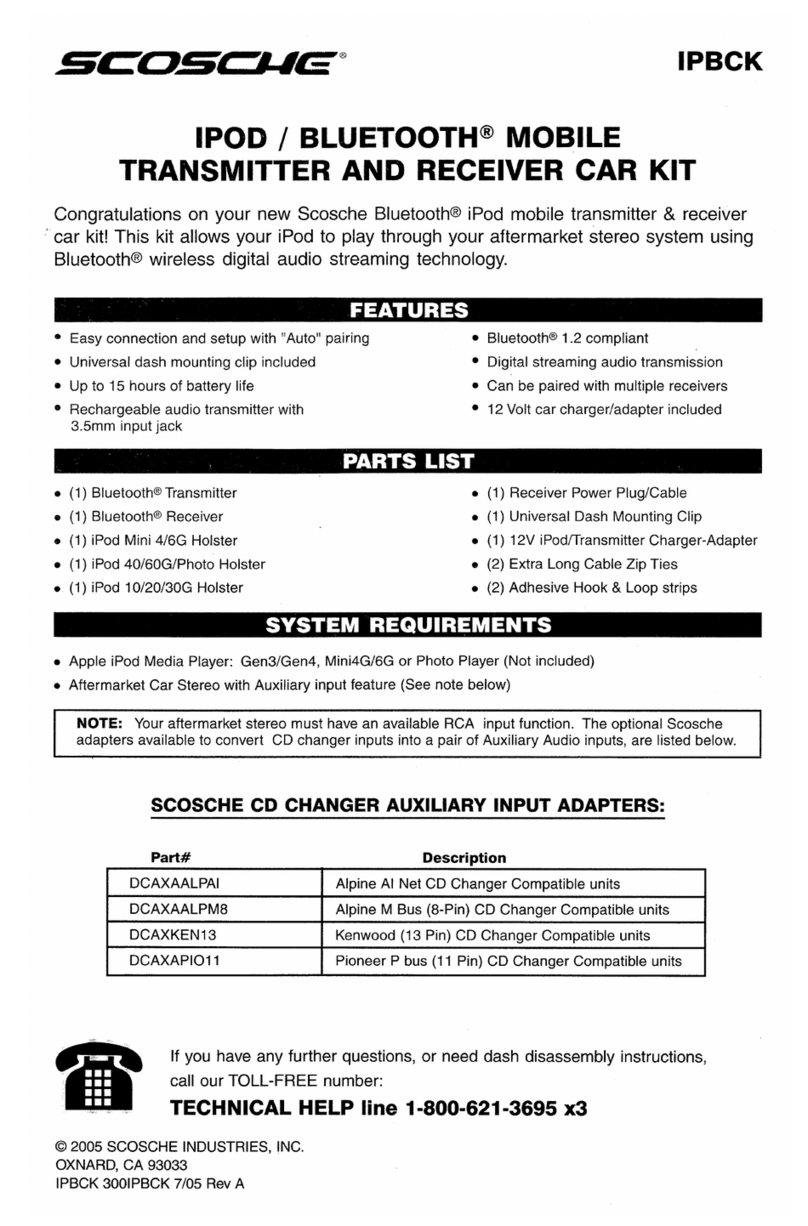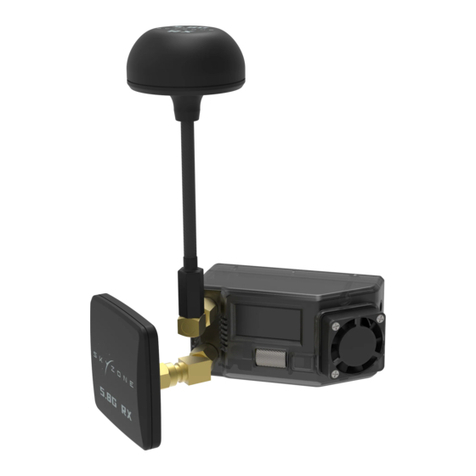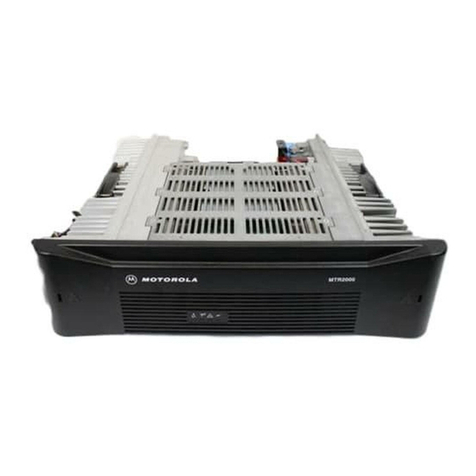Vivax Metrotech vLoc3-Pro Instruction Manual

vLoc3-Pro User Handbook
(English Edition)
Version 1.2
P/N: 4.04.000105
Locators & Supplies, Inc.
(800) 950-6666
sales@locatorsandsupplies.com
www.locatorsandsupplies.com


™
Table of Content
1. General Safety & Care Information ....................................................................................................................1
1.1 Who Can Use This Equipment .................................................................................................................1
1.2 Work-site Safety .......................................................................................................................................1
1.3 Equipment Safety .....................................................................................................................................1
1.4 Batteries and Environmental Safety .........................................................................................................1
1.4.1 Alkaline Batteries (Non-Rechargeable) .......................................................................................1
1.4.2 Nickel-Metal Hydride Batteries (Rechargeable) ..........................................................................1
1.4.3 Lithium-Ion Batteries (Rechargeable)..........................................................................................2
1.4.4 Lithium-Metal Batteries (Non-Rechargeable)..............................................................................2
1.4.5 General Rules regarding Disposal of Batteries ...........................................................................2
1.4.6 Transportation of Lithium-Ion and Lithium-Metal Batteries..........................................................2
1.5 Care of Equipment....................................................................................................................................3
1.6 Care when Interpreting the Information provided by the Locator .............................................................3
1.7 American & Canadian Safety Notices.......................................................................................................3
2. Service & Support...............................................................................................................................................4
2.1 Serial Number and Software Revision Number........................................................................................4
2.2 Distributors and Service Centers Closest to You:.....................................................................................5
3. vLoc3-Pro Receiver............................................................................................................................................6
3.1 vLoc3-Pro Receiver Overview..................................................................................................................6
3.2 Charging the Receiver Batteries...............................................................................................................7
3.3 vLoc3-Pro Receiver Keypad.....................................................................................................................8
3.4 User Menu................................................................................................................................................8
3.4.1 About ...........................................................................................................................................9
3.4.2 Speaker Volume..........................................................................................................................9
3.4.3 Sound Conguration....................................................................................................................9
3.4.4 Backlight......................................................................................................................................9
3.4.5 Frequency....................................................................................................................................9
3.4.6 Classic Locate...........................................................................................................................10
3.4.7 Locate Perspective....................................................................................................................10
3.4.8 Language...................................................................................................................................10
3.4.9 Imp/Metric..................................................................................................................................10
3.4.10 Continuous Info .........................................................................................................................10
3.4.11 Auto Power O...........................................................................................................................10
3.4.12 Warnings ...................................................................................................................................10
3.4.13 Bluetooth Pairing (Optional Feature).........................................................................................10
3.4.14 Self-Test.....................................................................................................................................11
3.5 Self-Test..................................................................................................................................................11
3.6 Warnings.................................................................................................................................................11
3.6.1 Signal Overload.........................................................................................................................11
3.6.2 Shallow Cable ...........................................................................................................................11
3.6.3 Swing Alert.................................................................................................................................12

™
3.6.4 Overhead cable.........................................................................................................................12
3.7 vLoc3-Pro Receiver Locate Screen Shots..............................................................................................12
3.8 Classic Locating Modes (Response)......................................................................................................14
3.8.1 Peak Response Mode ......................................................................................................14
3.8.2 Broad Peak Mode ............................................................................................................14
3.8.3 Null Mode .........................................................................................................................15
3.8.4 Delta Null .........................................................................................................................15
3.8.5 Peak with Arrows Response Mode ..................................................................................15
3.8.6 Omni Peak Response Mode ............................................................................................16
3.9 Information Pushbutton (Depth & Current).............................................................................................16
4. Using the vLoc3-Pro.........................................................................................................................................21
4.1 Using the Receiver .................................................................................................................................21
4.2 Passive Locating.....................................................................................................................................21
4.2.1 Detecting Power Signals ...........................................................................................................22
4.2.2 Detecting Radio Signals............................................................................................................23
4.3 Active Locating:- Applying the Transmitter..............................................................................................23
4.3.1 Direct Connection......................................................................................................................23
4.3.2 Signal Clamp (for frequencies above 8kHz)..............................................................................25
4.3.3 Induction (for frequencies above 8kHz).....................................................................................26
4.4 Locating Active Signals...........................................................................................................................27
4.5 Searching (sweeping) an Area in the Peak Mode...................................................................................28
4.6 Searching (sweeping) an Area in the Omni Peak Mode.........................................................................28
4.7 Tracing a Buried Line..............................................................................................................................28
4.8 Depth & Current Measurement...............................................................................................................29
4.9 Distorted Fields.......................................................................................................................................29
4.10 Sonde Location Mode.............................................................................................................................30
4.11 Signal Direction Precision Identication..................................................................................................32
5. Data Logging....................................................................................................................................................35
5.1 Bluetooth.................................................................................................................................................36
5.1.1 Fitting the Bluetooth Module......................................................................................................36
5.2 Pairing with external GPS/Dataloggers ..................................................................................................36
5.3 Transferring Data from the Locator to a Computer.................................................................................37
5.3.1 MyLocator3................................................................................................................................37
5.3.2 My Locator3’s Basic Operation..................................................................................................38
5.3.2.1 Updates Page............................................................................................................38
5.3.2.2 Application Update.....................................................................................................38
5.3.2.3 Locator Firmware update...........................................................................................39
5.3.3 Toolbar.......................................................................................................................................40
5.3.4 Data Logging.............................................................................................................................40
5.3.5 Splash Screen...........................................................................................................................41
5.3.6 Frequencies Page .....................................................................................................................42
5.3.7 Menu Settings............................................................................................................................43
5.3.8 Advanced Features....................................................................................................................44

™
5.3.8.1 Supervisor Lockouts ..................................................................................................44
6. Loc3-10Tx Transmitter......................................................................................................................................45
6.1 Loc3-10Tx Transmitter Overview............................................................................................................45
6.1.1 Display.......................................................................................................................................45
6.1.2 Pushbuttons...............................................................................................................................46
6.1.3 Information Pushbutton .............................................................................................................46
6.1.4 Connections Block.....................................................................................................................46
6.2 Transmitter Battery .................................................................................................................................47
6.2.1 Removing the Battery Tray........................................................................................................47
6.2.2 Replacing the Alkaline Battery...................................................................................................47
6.2.3 Rechargeable Batteries.............................................................................................................48
6.2.4 Re-tting the Battery Tray..........................................................................................................48
6.2.5 Rechargeable Battery Pack Charging and Disposal .................................................................48
6.3 Transmitting Modes ................................................................................................................................49
6.3.1 Induction Mode..........................................................................................................................49
6.3.2 Direct Connection Mode............................................................................................................49
6.3.3 Clamp Mode..............................................................................................................................50
6.4 Frequencies............................................................................................................................................50
6.4.1 Frequencies and Power Output.................................................................................................50
6.4.2 Most Used Frequencies (Frequency Selection) Feature...........................................................51
6.4.3 Multi-Frequency Mode for Direct Connection............................................................................53
6.5 Remote the Operation of transmitter ......................................................................................................54
7. Loc3-5Tx Transmitter........................................................................................................................................58
7.1 Loc3-5Tx Transmitter Overview..............................................................................................................58
7.1.1 Display.......................................................................................................................................58
7.1.2 Pushbuttons...............................................................................................................................59
7.1.3 Information Pushbutton .............................................................................................................59
7.2 Transmitter Battery .................................................................................................................................59
7.2.1 Removing the Battery Tray........................................................................................................59
7.2.2 Replacing the Alkaline Battery...................................................................................................60
7.2.3 Rechargeable Batteries.............................................................................................................60
7.2.4 Re-tting the Battery Tray..........................................................................................................60
7.2.5 Rechargeable Battery Pack Charging and Disposal .................................................................60
7.3 Transmitting Modes ................................................................................................................................61
7.3.1 Induction Mode..........................................................................................................................61
7.3.2 Direct Connection Mode............................................................................................................61
7.3.3 Clamp Mode..............................................................................................................................62
7.4 Frequencies............................................................................................................................................63
7.4.1 Frequencies and Power Output.................................................................................................63
7.4.2 Most Used Frequencies (Frequency Selection) Feature...........................................................64
7.4.3 Multi Frequency Mode for Direct Connection............................................................................65
7.5 Transmitter Battery .................................................................................................................................66
7.5.1 Replacing Alkaline Batteries......................................................................................................66
7.5.2 Rechargeable Batteries.............................................................................................................67

™
7.5.3 Battery Charging and Disposal..................................................................................................67
8. Using the Accessories......................................................................................................................................68
8.1 Using the LPC Separation Filter.............................................................................................................68
8.2 Using the Analogue A-frame Fault Finding Accessory...........................................................................68
8.3 Using the vLoc3-Pro Remote Antenna...................................................................................................71
8.4 Using the SD Signal with the Remote Antenna to help trace a particular cable.....................................74
9. Accessories & Options......................................................................................................................................77
9.1 A-frame...................................................................................................................................................77
9.2 Remote Antenna.....................................................................................................................................77
9.3 Loc3 Series Vehicle Power Lead............................................................................................................77
9.4 Loc3 Series Outdoor Power Supply........................................................................................................77
9.5 LPC Separation Filter .............................................................................................................................77
9.6 Receiver Vehicle Charging Lead ............................................................................................................78
9.7 Sondes....................................................................................................................................................78
9.8 Clamps....................................................................................................................................................79
9.9 Clamp Extension Rod.............................................................................................................................79
9.10 Ground Extension Spool.........................................................................................................................79
9.11 Banana Plug Adapter..............................................................................................................................79
9.12 Loc3 Series Charger...............................................................................................................................80
9.13 Loc3 Series Rechargeable Battery Tray.................................................................................................80
9.14 Live Plug Connector (LCC).....................................................................................................................80
9.15 vLoc3-MLA (Marker Locator Adapter) ....................................................................................................80
10. Glossary ...........................................................................................................................................................81

™
Page 1 of 81
1 General Safety & Care Information
1. General Safety & Care Information
1.1 Who Can Use This Equipment
●This equipment must only be used by people suitably trained in the use of pipe and cable locators.
1.2 Work-site Safety
●Use your company’s, or other applicable safety codes and rules when using this equipment.
●Unless having the required authorization, license and appropriate training – do not make connections to any pipe, cable or
conductor.
●The equipment should not come in contact with corrosive or hazardous chemicals, or gases or dust.
●Do not directly connect this equipment to cables or pipes that have a potential difference to ground of greater than 25VAC.
1.3 Equipment Safety
●Do not open the enclosures (housings) of either the transmitter or receiver.
●Place the ground stake firmly in the ground before connecting the cable from the transmitter.
●Do not hold any uninsulated portion of the connection leads & clips when the transmitter is switched on.
1.4 Batteries and Environmental Safety
Vivax-Metrotech products use four types of batteries:
●Alkaline batteries
●Ni-MH (Nickel-Metal Hydride) batteries – rechargeable
●Lithium-Ion batteries – rechargeable
●Lithium-Metal batteries – (small non-rechargeable button cells for “clock” applications)
1.4.1 Alkaline Batteries (Non-Rechargeable)
●When replacing the alkaline batteries – use only the size and type specified – do not mix battery types (rechargeable and
alkaline).
●Do not mix partially discharged and fully charged cells in the same battery pack – do not mix old with new.
●Never attempt to charge alkaline batteries.
1.4.2 Nickel-Metal Hydride Batteries (Rechargeable)
●When using rechargeable batteries, use only the correct charging device supplied or specified by the manufacturer. The
battery pack or the battery charger will contain circuitry to manage the charging process – other chargers (even if they have
the same connector, polarity, voltage & current rating will not have the same control circuitry and can cause damage to the
product, overheating, and in extreme cases fire or harm to the individual.
●Do not assume that if the plug fits, it is the correct charger – a charger with the correct part number must be used – just
because it is a Vivax-Metrotech charger, and the plug fits does not mean it is the correct charger.
●Before using for the first time, charge rechargeable batteries for six hours. If at any time the rechargeable batteries do not
last as long as anticipated – discharge fully and then charge for six hours.
●Care should be taken when charging batteries – Never repeatedly recharge batteries (or turn power off & on) without using
the instrument. If used with an inverter in a vehicle – charge the product then unplug the charger and do not charge again
until the rechargeable batteries have been used for at least ten minutes. Failure to do this could result in the overcharging of
the battery which will shorten the life of the battery and could in some circumstances cause overheating or fire.

™
Page 2 of 81
1 General Safety & Care Information
●If ever the product becomes hot during the charging process, immediately unplug the charger and use the rechargeable
batteries for at least ten minutes before recharging. If this reoccurs the next time the unit is charged – return immediately to
Vivax-Metrotech for repair.
●Do not charge batteries for prolonged periods of time without using the locator for at least ten minutes. Charging for
prolonged period of time could overcharge the battery, reduce the battery life and in extreme circumstances cause damage
to the locator and fire.
1.4.3 Lithium-Ion Batteries (Rechargeable)
●Lithium-Ion Batteries – some products use Lithium-Ion batteries – the requirements for marking and transportation are still
developing. Please contact Vivax-Metrotech before shipping products containing Lithium-Ion batteries or Lithium-Ion battery
packs on their own for any “special instructions”.
1.4.4 Lithium-Metal Batteries (Non-Rechargeable)
●Commonly known as “button cells” these are small – non-rechargeable batteries used to power internal “clocks” within some
units (similar to computers). Generally, they have a life of three to five years.
●Under no circumstances should any attempt be made to charge these batteries.
●Dispose of to your company’s work practice/environmental standards, the prevailing laws, or recognized best practice.
Always dispose of batteries responsibly.
1.4.5 General Rules regarding Disposal of Batteries
●Never disassemble a battery, or battery pack.
●Never dispose of in a fire or water.
●Dispose of batteries in accordance with your company’s work practice/environmental standards, the prevailing laws, or
recognized best practice. Always dispose of batteries responsibly.
1.4.6 Transportation of Lithium-Ion and Lithium-Metal Batteries
●The Lithium-Ion and Lithium-Metal batteries used in Vivax-Metrotech products meet the required safety standards and
include the designated protection circuitry.
●Recent regulation changes require that when batteries with Lithium-Ion and Lithium-Metal batteries are transported, the
packaging must include specified warning labels.
●Please contact Vivax-Metrotech Customer Service (USA 1-800-446-3392, International +1-408-734-1400 (USA Pacific
Time Zone)) for more details.
●Regulations have also changed regarding the shipping of spare battery packs (battery packs that are not inside a product).
There are limitations on the weight of the package, and the packaging must be marked with the appropriate warning labels.
●Please contact Vivax-Metrotech Customer Service (USA 1-800-446-3392, International +1-408-734-1400 (USA Pacific
Time Zone)) for more details.
●Vivax-Metrotech vLoc Series 2 products using Lithium-Ion battery are classified as “not restricted” they can be shipped
normally by road/rail/sea & air (passenger & freight aircraft) without restrictions.
IMPORTANT
Remember – Batteries contain dangerous chemicals – They can be affected by many things such
as water ingress or heat – In some circumstances they can explode. They also can cause electric
shocks!

™
Page 3 of 81
1 General Safety & Care Information
1.5 Care of Equipment
●Use equipment only as directed in this User Handbook.
●Do not immerse any part of this equipment in water.
●Store in a dry place.
●Keep equipment in the case provided when not in use.
●If left for prolonged period of time – remove alkaline batteries.
●Keep unit clean and free of dust and dirt.
●Protect against excessive heat.
1.6 Care when Interpreting the Information provided by the Locator
●Like all locators – this instrument is locating and providing depth and current readings based on electromagnetic signals that
radiate from the buried cable or pipe. In most cases these signals will enable the locator to pinpoint both position depth and
current correctly.
●Beware – in some cases other factors will distort electromagnetic fields radiating from cable or pipe being located, resulting
in incorrect information.
●Always locate responsibly and use information learned during your training to interpret the information provided by the
locator.
●Do not provide information regarding depth of cable or pipe to anyone unless authorized to do so by your company.
●Remember that depth measurements are to the center of the electromagnetic field or pipe – In the case of pipes this may
be significantly deeper than the top of the pipe.
1.7 American & Canadian Safety Notices
USA
●This transmitter and receiver comply with the general conditions of operation, pursuant to part 15 of the FCC Rules.
οCFR 47 Part 2
οCFR 47 Part 15
●Changes or modifications not expressly approved by the manufacturer could void the user’s authority to operate the
products.
CANADA
●Equipment is for use by trained operators only, and not for general household or consumer use.
●Operation is subject to the following two conditions: (1) this device may not cause interference, and (2) this device must
accept any interference that may cause undesired operation of the device.
EUROPE
●Vivax-Metrotech confirms that the location system is compliant with relevant provision of European directive 1999/5/EC.
οEN 55011
οEN 61000-4-2: A1 &A2
οEN 61000-4-3
οEN 61000-4-8: A1
οETSI EN 300 330-2
οETSI EN 301 489-1
οETSI EN 301 489-3

™
Page 4 of 81
2 Service & Support
2. Service & Support
2.1 Serial Number and Software Revision Number
Always quote your receiver and transmitter model number, serial number and software revision number when requesting product
support. They can be found as follows: (for reference only).
1
1
1
1 Model & Serial Number
NOTE
The transmitter Model & Serial Number can be found at the bottom of the transmitter and also inside
the transmitter between the battery tray and the main module of transmitter.
Software Revision Number: On both receiver and transmitter the software revision number is
displayed on the LCD during the startup sequence or can be found in the “About” section of the user
menu.

™
Page 5 of 81
2 Service & Support
2.2 Distributors and Service Centers Closest to You:
World Headquarters, United State of America
Vivax-Metrotech Corporation
3251 Olcott Street,
Santa Clara, CA 95054, USA
Website : www.vivax-metrotech.com
Sales & Sales Support:
T/Free : 800-446-3392
Tel : +1-408-734-1400
Fax : +1-408-734-1415
Service & Repairs:
T/Free : 800-638-7682
Tel : +1-408-962-9990
Fax : +1-408-734-1799
Australasia
Vivax-Metrotech AUS
Unit 1, 176 South Creek Road,
Cromer NSW 2099, Australia
Tel : +61-2-9972-9244
Fax : +61-2-9972-9433
Website : www.vivax-metrotechaus.com
Canada
Vivax Canada Inc.
41 Courtland Ave Unit 6,
Vaughan, ON L4K 3T3, Canada
Tel : +1-289-846-3010
Fax : +1-905-752-0214
Website : www.vivax-metrotech.com
Germany
Metrotech Vertriebs GmbH
Am steinernen Kreuz 10a
D-96110 Schesslitz
Tel : +49 954 277 227 43
Central/South America and the Caribbean
Ventas para América Latina
3251 Olcott Street,
Santa Clara, CA 95054, USA
T/Free : 800-624-6210
Tel : +1-408-734-1400
Fax : +1-408-743-5597
Website : www.vivax-metrotech.com
China
Leidi Utility Supply (Shanghai) Ltd.
No. 780, Tianshan Rd,
Shanghai, China 200051
T/Free : 4008-206-719
Tel : +86-21-5235-3001
Fax : +86-21-5235-8365
Website : www.leidi.cn
France
Vivax-Metrotech SAS
Technoparc - 1 allée du Moulin Berger,
69130 Ecully, France
Tel : +33(0)4 72 53 03 03
Fax : +33(0)4 72 53 03 13
Website : www.vivax-metrotech.com
United Kingdom
Vivax-Metrotech Ltd.
Unit 18-19, Woodside Road,
South Marston Industrial Estate,
Swindon, SN3 4WA, UK
Free Phone : 0800 0281811
Tel :+44(0)1793 822679
Website : www.vivax-metrotech.com

™
Page 6 of 81
3 vLoc3-Pro Receiver
3. vLoc3-Pro Receiver
3.1 vLoc3-Pro Receiver Overview
The vLoc3-Pro is a Precision Location System designed to meet the needs of utility companies and their contractors. The
following describes the features and use of the receiver.
1
2
3
456 7 8 9
1 vLoc3-Pro receiver
2 Mini-USB cable
3 Li-ion battery
4 Charger
5AAAlkaline batteries
6 Alkaline battery holder
7Power cable for charger
*one of supplied based on geographical location
8 User manual
9 Soft kit carry bag
1
2
3
4
5
6
78
1 Pushbutton keypad display 5 Mini-USB port for data transfer and software updates
2 Model number# & Serial number# 6 Battery compartment cover
3 Battery retaining cover 7 Accessory socket and charging point
4 AAAlkaline Battery Pack/Rechargeable Battery Pack 8 Expansion sockets for additional features such as the
blue tooth module

™
Page 7 of 81
3 vLoc3-Pro Receiver
3.2 Charging the Receiver Batteries
The vLoc3-Pro can be used with either alkaline batteries or an interchangeable rechargeable battery pack.
The central illuminated section within the battery icon indicates the amount of charge remaining.
●Blue centre indicates alkaline batteries.
●Green centre indicates rechargeable batteries.
●When batteries are low the charge remaining section becomes red and will flash.
Just before shutdown the following symbol will be shown:
Rechargeable batteries are supplied with a mains charger. This is specic to the batteries, avoid the use of other manufacturers’
chargers as these may damage the battery pack and may result in overheating of the battery pack.
To charge the rechargeable batteries, rst make sure the pack is inserted in the receiver battery compartment as charging is
done with the battery inside the receiver.
Connect the charger to the charging/accessory socket of the receiver. Connect the charger to the mains and switch on. The LED
indicator on the charger will illuminate red until the batteries are fully charged at which time the LED will change to green.
WARNING
Rechargeable batteries are supplied with a mains or 12V DC charger. These are specific to the
batteries. Only use the charger that is appropriate for the batteries in the product. If in doubt, call
the Vivax-Metrotech customer service department at +1(800) 446-3392. Failure to use the appropriate
charger could result in damage to the battery pack, locator and in extreme cases cause re.
Avoid charging the unit in extreme temperature conditions. (i.e. below 0ºC and above 45ºC)
Although Vivax-Metrotech batteries include all the required safety related features, immediately
discontinue use of the charger and battery pack if the battery pack becomes excessively warm.
Return both to where they were purchased for investigation.

™
Page 8 of 81
3 vLoc3-Pro Receiver
Always ensure batteries have at least a partial charge if storing for long periods without use.
Dispose of all batteries in accordance with your company procedures and or Federal/State and local
regulations.
Never dismantle batteries, put them in re, or get wet.
3.3 vLoc3-Pro Receiver Keypad
Keypad:
1 2 543
6
1On/O 4Increase sensitivity. (Also scroll down when in User
Menu)
2 Reduce sensitivity. (Also scroll up when in User Menu) 5 Short press = change antenna response
Long press = change operational screen
3 Select frequency 6 Short press = enter information screen
Long press = enter User Set-up options
3.4 User Menu
The vLoc3-Pro has several features that can be switched on and o. These features are accessed through the user menu.
Switch on the unit by pressing and holding the On/Off key until the start-up screen appears. The start-up screen can be
congured to the user’s preference and is described later in the manual. Otherwise the start-up screen will default to the one
below:

™
Page 9 of 81
3 vLoc3-Pro Receiver
Access to the User Menu is via the “i” button. Press and hold down the button until the menu appears.
Menu
About
Speaker Volume
Sound Configuration
Backlight
Frequency
Classic Locate
Locate Perspective
Auto
Menu
Language
Imperial / Metric
Continuous Information
Auto Power Off
Warnings
Bluetooth Pairing
Self Test
English
Feet
Depth & current
10 Minutes
Main Menu
Note that the manual shows three screens but only one is shown on the vLoc3-Pro display at a time.
Note that where you see this sign it means that pressing the enter button gives access to the sub-menu associated with this
button.
To exit the menu or sub-menu, press the “i” button.
Where the icon is not shown, the enter button is used to scroll through the options of that feature.
Use the “+” and “- “buttons to scroll up and down through the menu.
The features are described below:
3.4.1 About
This section holds the data about the locator such as software revision, calibration data etc.
3.4.2 Speaker Volume
Press the enter button to scroll through the speaker volume settings.
3.4.3 Sound Conguration
Allows conguration of sounds generated in locate modes.
●Active mode:
οFrequency Modulated (FM) Sound pitch changes with signal strength.
οAmplitude Modulated (AM) Sound volume changes with signal strength.
●Radio mode: FM or Real (Sound derived directly from received signal).
●Power mode: FM or Real.
3.4.4 Backlight
Press the enter button to change the backlight intensity setting. Note that high backlight setting will aect battery life. Or select
“Auto” which automatically sets backlight depending on ambient light levels.
3.4.5 Frequency
Use the enter key to enter the Frequency sub-menu. Scroll up and down the table using the “+” and “-” keys. The table contains
all available frequency options. To simplify the operation of the unit, select only the frequencies applicable to your application. To
do this use the enter key to check the boxes on the right. Frequencies not checked will not appear of the locate screen.
Frequency
1.45kHz
2.0kHz
8.01kHz
8.19kHz
8KFF
8.44kHz
9.5kHz
9.8kHz

™
Page 10 of 81
3 vLoc3-Pro Receiver
Note also that certain frequency options have an A-frame icon next to them. This indicates that these frequencies are selected to
be used with the fault nd A-frame.
3.4.6 Classic Locate
This option is only shown if the User menu is entered from the Classic Screen.
Use the enter key to reveal the list of options relating to the Classic Locate modes. Options are:
Classic Locate
Peak
Peak Arrows
Null
Broad
Delta Null
Omni Directional Peak
Omni Directional Peak
3.4.7 Locate Perspective
Enter this option to be able to select in what graphical format the data is displayed. These displays are described further in the
manual. The options are:
Locate Perspective
Classic Locate
Vector locate
Transverse graph
Plan view
Sonde
3.4.8 Language
The unit may be supplied with dierent language options. Use the enter key to select the language of choice.
3.4.9 Imp/Metric
Select either Imperial or Metric measurements.
3.4.10 Continuous Info
The front Locate Screen can display a continuous reading of either depth, current, both or can be switched o. Use the enter
button to select your preference.
3.4.11 Auto Power O
The unit can be set to switch o after a set time. Options are: 5-minutes, 10-minutes, or Never. Note that when the A-frame is
connected the timer is set to “Never”.
3.4.12 Warnings
Warnings relating to: - Shallow cable, Overload, Overhead cable and Signal Overload. Scroll down to the relevant warning and
use the return button to select or de-select.
3.4.13 Bluetooth Pairing (Optional Feature)
Press the enter button to enter the Bluetooth pairing routine. This allows the unit to link with external devices such as
dataloggers and GPS devices that have Bluetooth capability.

™
Page 11 of 81
3 vLoc3-Pro Receiver
3.4.14 Self-Test
Pressing the enter key will initiate a series of self-tests. If any of the tests fail repeat the test in a more interference free site
i.e. away from uorescent lights, power signal sources etc. If the unit continues to fail, the unit should be returned to Vivax-
Metrotech Corporation or one of its authorised service centres for repair.
3.5 Self-Test
The vLoc3-Pro has a self-test feature. The test conrms that the equipment is t for use and calibration has not drifted from its
expected settings.
To undertake the test, rst nd an area free from excessive interference such as overhead uorescent lighting, large
transformers etc. Also check that any nearby vLoc transmitters are switched o.
Select “Self-Test” from the user menu and press the “Return” button. The test will self-start. Keep the equipment stationary while
the test is completed. After a short while the unit will report a Passed or Failed. Examples are below:
108.1
63.1
88.6
87.0
Self Test: PASSED
108.1
63.1
88.6
87.0
Self Test: FAILED
If the unit fails the test, try again in a more interference free area. If it continues to fail, return the unit to Vivax-Metrotech or one
of its approved repair centres for investigation and repair.
3.6 Warnings
Warnings are displayed in real time across the display as below:
61.4 SD-EUR24dB
3.6.1 Signal Overload
This a very unusual situation and is usually caused by operating very close to a power transformer or placing
the unit very close to a transmitter in the Induction mode. Moving slightly away from the interfering signal will
cure the problem. Signal overload will not cause damage to the instrument.
3.6.2 Shallow Cable
This indicates that the locator has detected a cable that is possibly less than 15cm deep. Proceed with
caution.

™
Page 12 of 81
3 vLoc3-Pro Receiver
3.6.3 Swing Alert
This indicates that the operator is swinging the locator excessively and could result in misleading information.
When sweeping the locator across the direction of the line, try to keep it vertical. This will improve accuracy.
3.6.4 Overhead cable
This indicates that the signal is mainly radiating from above. This is usually caused by the signal travelling
along overhead cables.
The warning symbols are accompanied by an audible sound and a vibration in the handle unless congured otherwise (See
MyLocator3). Warnings can also be switched o in the User Set-up Menu.
3.7 vLoc3-Pro Receiver Locate Screen Shots
The user interface of the vLoc3-Pro is under continual development. The screen shots described may dier slightly from current
screens.
The vLoc3-Pro gives the user a choice of different locate screens. The choice of screen depends on application and user
preference.
●Classic Screen
●Vector Screen
●Plan view Screen
●Transverse Plot Screen
This manual will rst explain the functions of the “Classic Screen” as familiarity of this screen will help understand the functions
of the others.
An overview of the Classic Screen
Classic Screen:
0.39m
18.3
17dB 116mA
SD-USA
Status bar:
All the screens have a status bar at the top which indicates various settings of the locator. The bar is shown below:
0.39m
18.3
21 3 875 64
1Antenna conguration (meter response) described later in the manual
2This icon is shown in this position when the sonde locate screen is selected
3 Depth to target line. (can also be set to display signal current on line or both)
4 Radio link to transmitter status

™
Page 13 of 81
3 vLoc3-Pro Receiver
5 Bluetooth status
6 GPS status
7 Speaker volume setting
8 Battery type and remaining charge
The Classic Screen has all the functions normally seen on a classic cable locator. The main functions being:
0.39m
18.3
17dB 116mA
SD-USA
3
21
4
567
8
1 Percentage signal strength (mirrors the bar graph setting)
2 Peak level indicator
3 Gain setting
4
Bar graph signal strength indicator (changes colour depending on distortion level)
Green: - low distortion
Blue: - Minor distortion, proceed with care
Red: - Excessive distortion, treat all data and measurements with caution
5 Signal Direction forward/back arrows (only active with Signal Direction frequencies)
6 Compass line direction indicator (turns blue when aligned with target line)
7 Left/Right direction to target line indicators
8Frequency selection (flashing frequency indicates frequency selection is not valid for this screen. Choose another
frequency)
Tip:
When in a locate screen, pressing and holding the “f” key will bring up the frequency table.
Radio
SD-EUR
8kHz
8KFF
33kHz
83kHz
200kHz
Use the “+” and “- “keys to navigate quickly to the desired frequency. Press the “i” key to select a highlighted choice and return
to the locate screen.

™
Page 14 of 81
3 vLoc3-Pro Receiver
Screen Icons explained
Classic Screen/Antenna congurations:
Icon Description Function/response
Peak Dual horizontal antennas giving largest signal over the line with sharp accurate results.
Less aected by distorted signals.
Null Vertical antenna giving minimum signal over the line with sharp response but more
affected by distorted signals. Can be used to identify distorted signals by comparing
results with the peak mode.
Broad peak Uses single antenna. Not so accurate as dual peak antennas and more dicult to pinpoint
the line but gives a signal boost from deep lines.
Delta-Null Uses dual null antennas to minimise the oset eects of eld distortion. This mode tends
to be more precise than the Null mode.
Peak with Arrows Same bar graph response as Peak but Left/Right Arrows indicate the Null locate position.
Good, general purpose mode, giving quick intuitive results.
Omni direction When you see the two double ended arrows around an icon, this means that the line is
detectable regardless of locator blade orientation. It is very useful for quickly checking an
area for buried lines.
3.8 Classic Locating Modes (Response)
The vLoc3-Pro receiver has an array of six antennas, and these can be toggled through dierent congurations (modes) to
provide dierent responses to the signals radiating from buried utilities. The modes are:
3.8.1 Peak Response Mode
Two horizontal antennas provide a “Peak” or maximum signal response over the center of
the buried line. The compass (line direction indicator) aligns itself parallel to the direction of
the cable (available in Active modes).
This is an accurate method of the locating as both horizontal antennas are used to provide a
clearly identiable “Peak”. It is also less prone to the eects of signal distortion.
A Peak Level Indicator is also provided on the bar graph. This indicates the largest signal
detected allowing the user to quickly return to this point.
3.8.2 Broad Peak Mode
This uses a single horizontal antenna and provides a “Peak” or maximum signal response
over the center of the buried line. The compass (line direction indicator) aligns itself parallel
to the direction of the cable (available in Active modes).
This gives a less dened peak than the twin horizontal antenna “Peak” mode – but is useful
in some situations such as deep lines because using a single antenna has the effect of
boosting the received signal.
Other manuals for vLoc3-Pro
2
Table of contents
Other Vivax Metrotech Receiver manuals

Vivax Metrotech
Vivax Metrotech vLoc3-Pro Installation guide

Vivax Metrotech
Vivax Metrotech vLoc3-Pro Instruction Manual
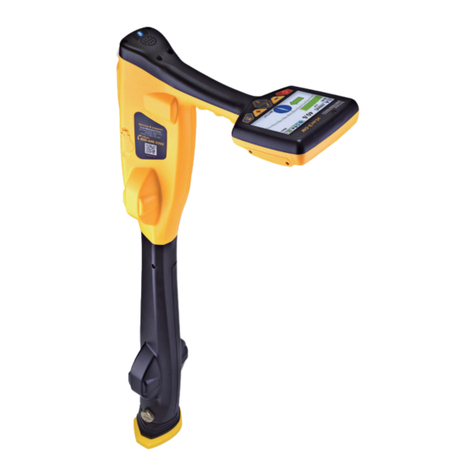
Vivax Metrotech
Vivax Metrotech vLoc3-DM Instruction Manual
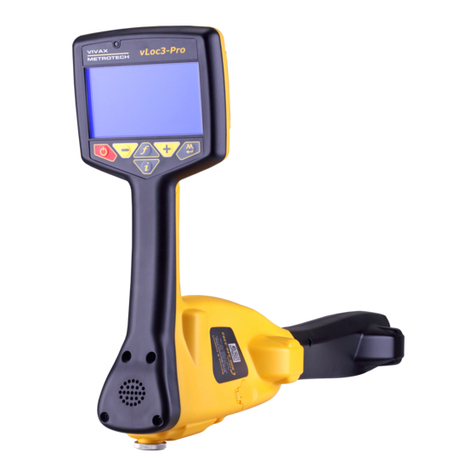
Vivax Metrotech
Vivax Metrotech vLoc3 Series Instruction Manual

Vivax Metrotech
Vivax Metrotech vLoc3 Series User manual

Vivax Metrotech
Vivax Metrotech vLoc3 Series User manual

Vivax Metrotech
Vivax Metrotech vLoc3 Series User manual
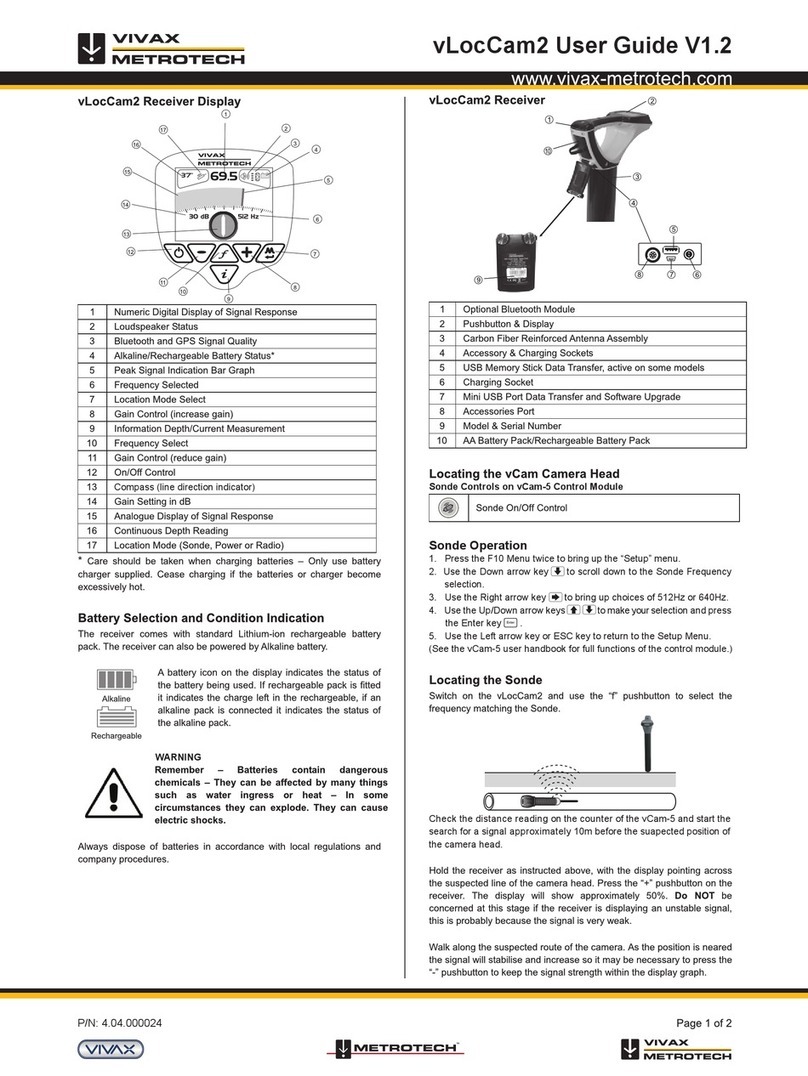
Vivax Metrotech
Vivax Metrotech vLocCam2 User manual
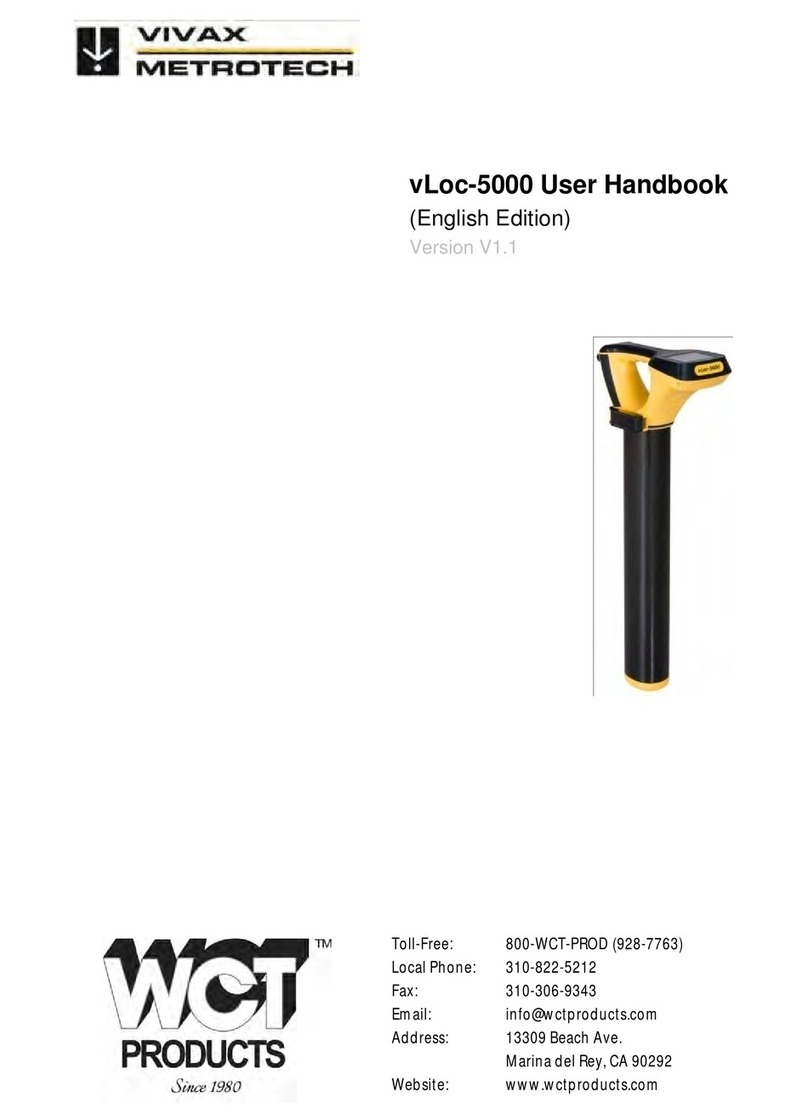
Vivax Metrotech
Vivax Metrotech vLoc-5000 Instruction Manual
